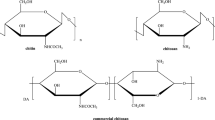Abstract
The purpose of this study was to assess the effect of a chitin derivative (CSE) on the adherence of Candida albicans to acrylic. Fungal adherence to acrylic dentures is considered an essential step in the development of denture stomatitis. Adherence of C. albicans to acrylic pieces (5 × 5mm) was assessed microscopically using a calibrated ocular objective and expressed as number of adherent yeasts/mm2 of acrylic.
CSE was prepared from commercial chitin (crab shell) and from chitin isolated from C. albicans blastospores. The effect of both CSE types on the adherence of C. albicans to acrylic was examined in two experimental systems: CSE present during the adherence assay and acrylic pieces pretreated with CSE prior to the assay. Both CSE types exerted a significant inhibitory effect when tested in the two experimental systems.
These findings are significant for possible prevention of denture stomatitis.
Similar content being viewed by others
References
BeacheyE., EisensteinB. and OfekI. (1982): Bacterial adherence in infectious diseases - In: Current Concepts. Upjohn Co, Kalamazoo, pp. 1–52.
BraunP.C. and CalderoneR.A. (1978): Chitin synthesis in Candida albicans: Comparison of yeast and hyphal forms - J. Bacteriol. 133: 1472–1477.
CritchleyI.A. and DouglasL.J. (1985): Differential adhesion of pathogenic Candida species to epithelial and inert surfaces - Fed. Eur. Microbiol. Soc. Microbiol. Lett. 28: 199–203.
DouglasJ. (1987): Adhesion to surfaces - In: Rose A.H. and Harrison J.S., eds. The yeasts - Academic Press, London, pp. 239–280.
KahaneM., SegalE., Schewach-MilletM. and GovY. (1988): In vitro adherence of Candida albicans to human corneocytes - Inhibition by chitin soluble extract - Acta. Dermato. Venereol. 68: 98–101.
KennedyM.J. (1988): Adhesion and association mechanisms of Candida albicans - Cuff. Top. Med. Mycol. 2: 73–169.
KingR.D., LeeJ.C. and MorrisA.L. (1980): Adherence of Candida albicans and other Candida species to mucosal epithelial cells - Infect. Immun. 27: 667–674.
LehrerN., SegalE. and Barr-NeaL. (1983): In vitro and in vivo adherence of Candida albicans to mucosal surfaces - Ann. Microbiol. 134: 293–306.
LehrerN., SegalE., LisH. and GovY. (1988): Effect of Candida albicans cell wall components on the adhesion of the fungus to human and murine vaginal mucosa - Mycopathologia 102: 115–121.
McCourtieJ., MacFarlaneT.W. and SamaranayakeL.P. (1985): Effect of chlorhexidine gluconate on the adherence of Candida species to denture acrylic - J. Med. Microbiol. 20: 97–104.
MinagiS., MiyakeY., InagakiK., TsuraH. and SuginakaH. (1985): Hydrophobic interaction in Candida albicans and Candida tropicalis to various denture base resin materials - Infect. Immun. 47: 11–14.
OddsF.C. (1988): Candida and candidosis. 2nd ed. -Bailliere Tindall, London.
RegezziJ.A. and SciubbaJ.J. (1989): Oral pathology: Clinical-pathologic correlations - W.B. Saunders Co., Philadelphia, pp. 110–116.
RotrosenD., CalderoneR.A. and EdwardsJrJ.E. (1986): Adherence of Candida species to host tissues and plastic surfaces - Rev. Infect. Dis. 8: 73–85.
SamaranayakeL.P., McCourtieS. and MacFarlaneT.W. (1980): Factors affecting the in vitro adherence of Candida albicans to acrylic surfaces - Arch. Oral Biol. 25: 611–615.
SegalE. (1985): Inhibition of attachment of Candida to animal cells and inert surfaces - J. Dent. Res. 64: 730, Abstr. No. 4.
SegalE. (1987): Pathogenesis of human mycoses: Role of adhesion to host surfaces - Microbiol. Sci. 4: 344–347.
SegalE. and SavageD. (1986): Adhesion of Candida albicans to mouse intestinal mucosa in vitro: Development of the assay and tests of inhibitors - J. Med. Vet. Mycol. 24: 477–479.
SegalE., GottfriedL. and LehrerN. (1988): Candidal vaginitis in hormone treated mice: Prevention by a chitin extract - Mycopathologia 102: 157–163.
SegalE., LehrmanO. and DayanD. (1988): Adherence in vitro of various Candida species to acrylic surfaces - Oral Surg. Oral Med. Oral Pathol. 66: 670–673.
SegalE., LehrerN. and OfekI. (1982): Adherence of Candida albicans to human vaginal epithelial cells: inhibition by amino sugars - Exp. Cell. Biol. 50: 13–17.
SpijkervetF.K.L., VanSaeneJ.J.M., VanSaeneH.K.F., PandersA.K., VermeyA. and FidlerV. (1990): Chlorhexidine inactivation by saliva - Oral Surg. Oral Med. Oral Pathol. 69: 444–449.
Author information
Authors and Affiliations
Additional information
Based on a thesis submitted to the Department of Human Microbiology, Sackler Faculty of Medicine, Tel Aviv University, in partial fulfillment of the requirements for the M.Sc. degree.




